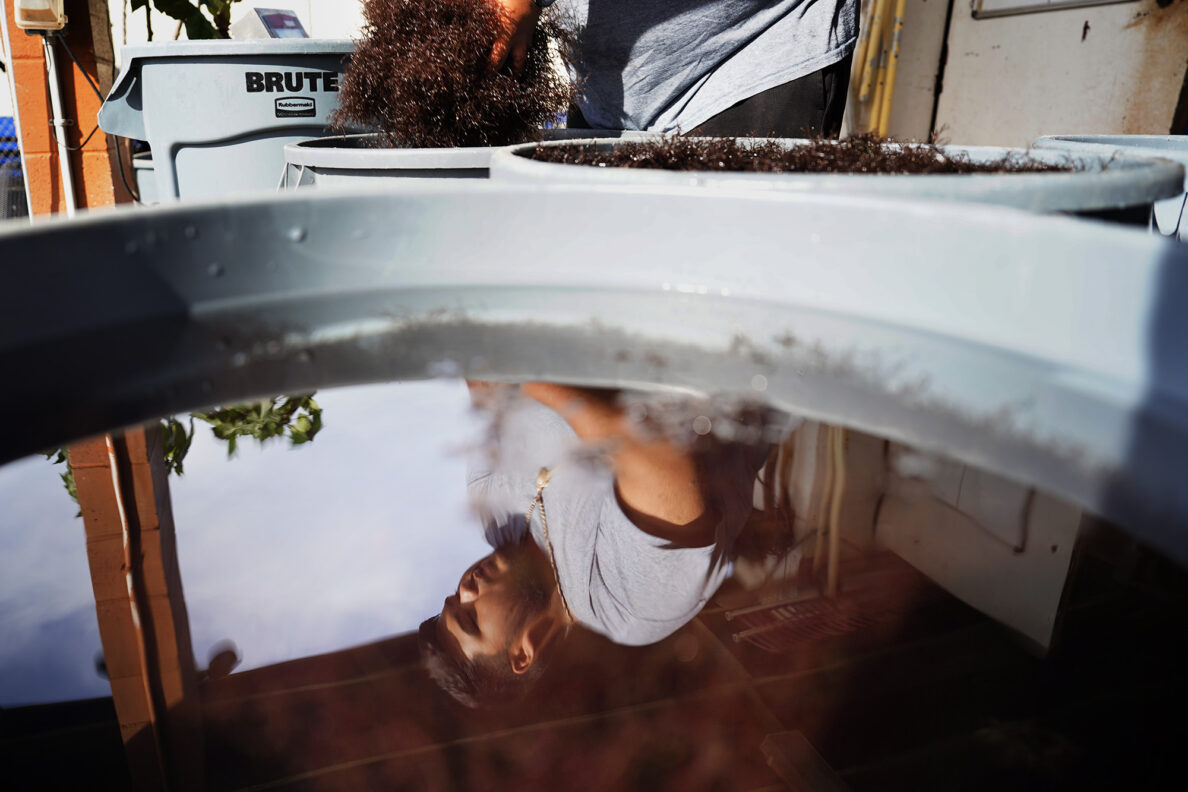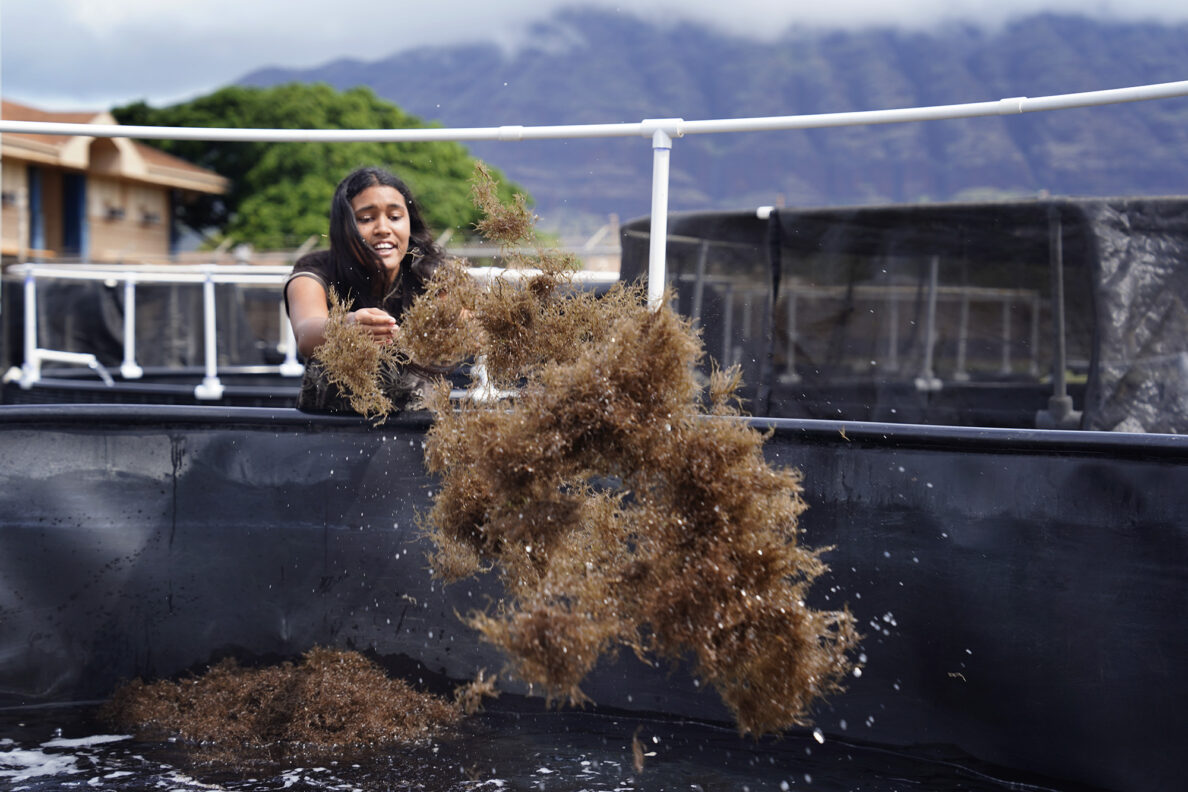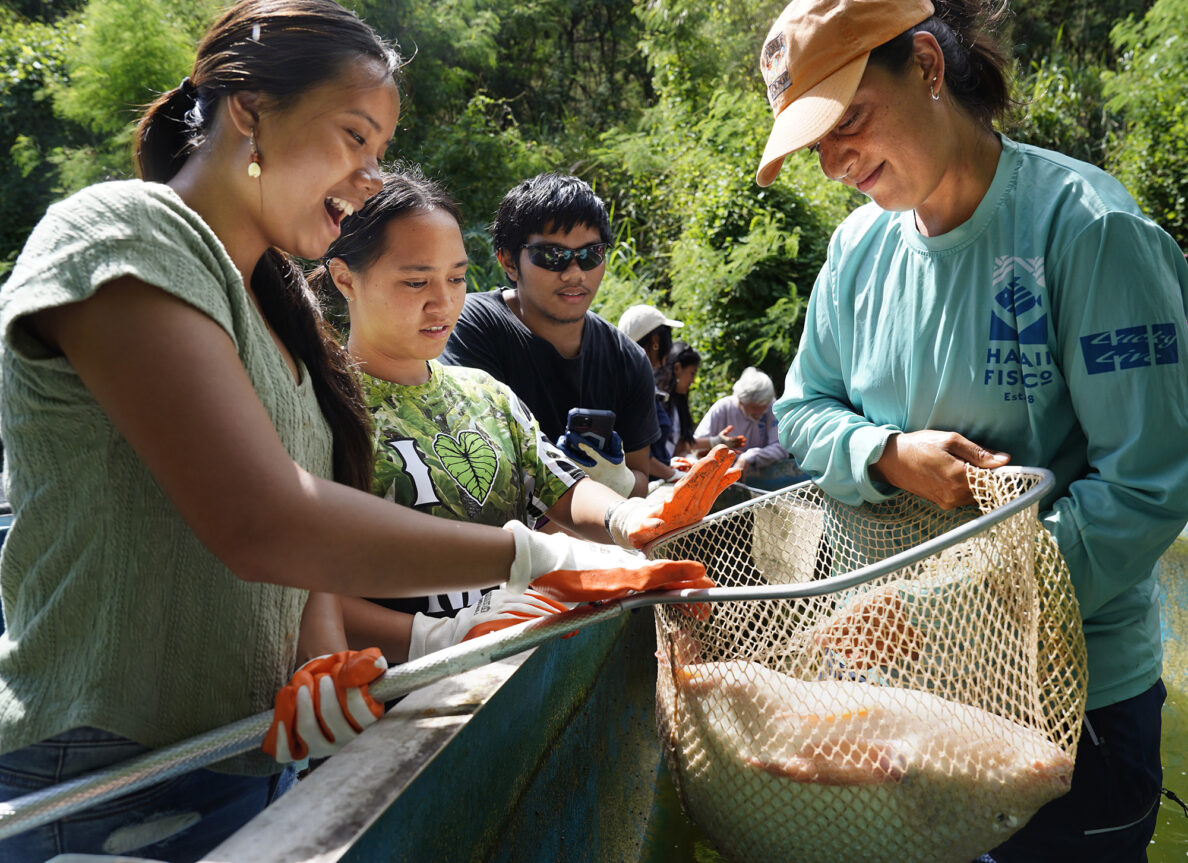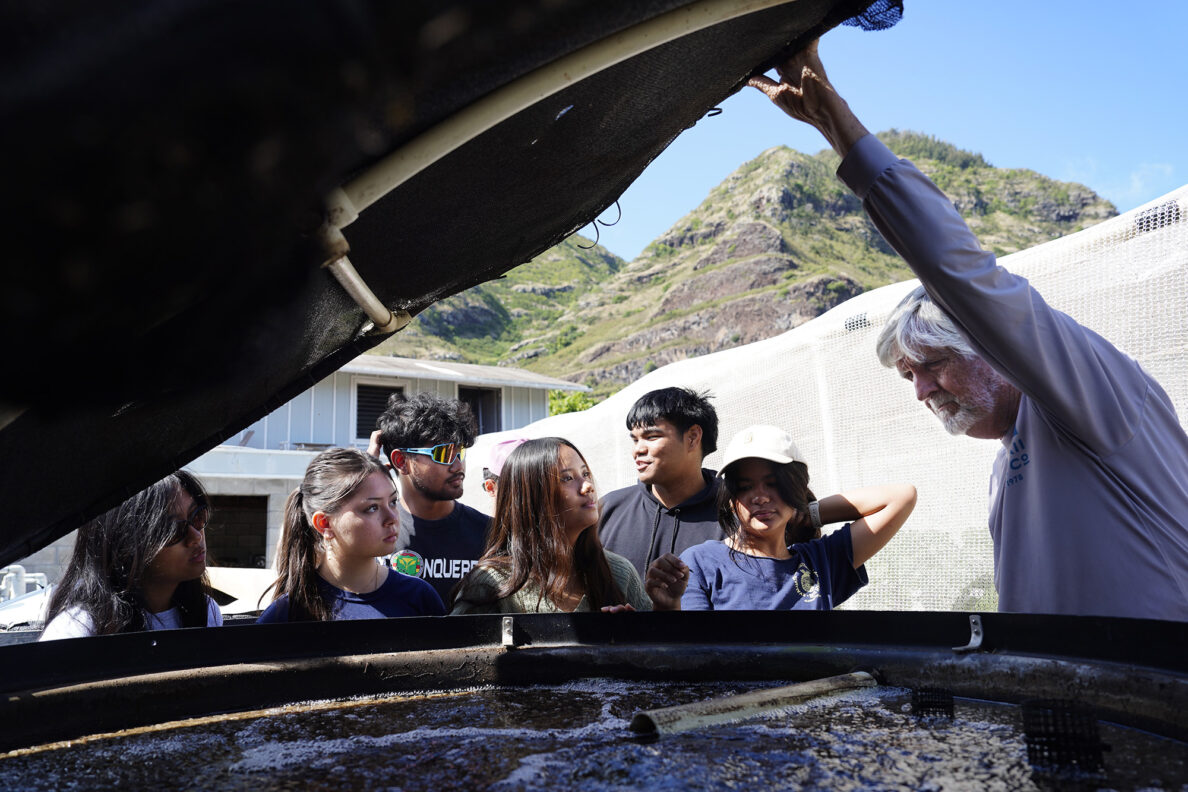Students Learn To Farm Fish, Seaweed. But Where Are The Jobs?
Aquaculture is projected to become Hawaiʻi’s strongest food industry, but state may not be doing enough to ensure there are good jobs in the future.

Droplets of blood red algae dance in a bubbling beaker in a Waiʻanae High School classroom, as Leihōkū Elementary schoolchildren huddle around.
Recent Waiʻanae graduate Hyrum Tom and teacher Tyson Arasato tell the visiting children all about the algae, limu kohu, a popular edible species native to Hawaiʻi. The algae population is declining in the wild, so the school is trying to grow it in captivity to feed the community and help the wild limu recover.
By next year, Arasato said, the school hopes to scale up from beakers to large tanks full of algae for the community to consume.
“Instead of them having to go out and pick it, where it’s not found as much, we’ll let it restore outside in the wild,” Arasato said. “Then we can actually supply people with the food that they need — that’s the goal of aquaculture.”
The Marine Science Learning Center is the only dedicated high school aquaculture center in the state, and it’s been expanding its operations in recent years to give students more hands-on experience cultivating and caring for species many believe could become the lifeblood of Hawaiʻi’s food system and economy.

The state’s aquaculture industry is expected to boom from a $90 million a year industry to $600 million a year in the next decade — according to the Department of Agriculture — and researchers say it will soon face a dearth of workers, which needs to be addressed if the industry is going to reach its full potential.
But it’s something of a Catch-22: despite predictions of workforce shortages and future growth, few of the students who have gone through the Waiʻanae center have found jobs in the field.
Part of the challenge is that many of the existing jobs require college degrees, something that less than one-third of Waiʻanae students pursue following graduation. A bigger issue is that jobs at any level of experience are limited at the moment.
“The big bottleneck is not that we can’t do workforce training,” said Maria Haws, an aquaculture professor at the University of Hawaiʻi Hilo. “It’s that we need to grow the industry.”
But the state has done little to invest in the industry in recent years and lawmakers have yet to heed calls from local industry leaders and researchers to encourage growth through regulatory reform or investments in infrastructure.
Now, as a major aquaculture producer shutters on the Big Island and another sues the state for crippling its business, concerns are growing over whether Hawaiʻi can actually achieve its potential.
Despite the uncertainty, leaders and students at the Marine Science Learning Center are continuing to build upon the center’s decades of research.
The school is now using grant funding to expand its footprint with new tanks, as part of its ultimate bid to boost Leeward Oʻahu’s food security and establish a hatchery for native fish to reestablish throughout the state. Those species include Waiʻanae’s namesake ʻanae — native mullet.
Restoring mullet’s place on the Westside is intended to help students connect with their heritage and sense of place, but also as a way to boost food self-sufficiency and address the region’s food insecurity, which is among the worst on Oʻahu.
“We need to get our fishponds functional again,” learning center coordinator Dana Hoppe said. “You want to talk about food security? That’s food security right there.”
Addressing Industry Challenges
Industry leaders have long said aquaculture is the most promising sector of agriculture for Hawaiʻi, a claim in line with global trends that show production and demand for farmed fish and other marine species is accelerating.
Hawaiʻi, they said, has a key role to play in the U.S. and global aquaculture industries — but the state has to address multiple obstacles for that to happen, according to a 2024 state report.
In addition to building a workforce pipeline, the state needs to simplify the regulatory landscape, to attract entrepreneurs and encourage more private and public investments in the sector.

The assessment, completed by an international aquaculture consultant group hired by the state, noted that the state needs to invest more in infrastructure to help foster that development, such as land and processing facilities.
But the workforce was a key issue, one nearly every aquaculture business surveyed noted. They struggled to find well-qualified candidates within the state, while also finding it difficult to attract out-of-state talent.
Without fixing the apparent workforce deficit, the report said, the state’s aquaculture outlook would only worsen.
But the state has yet to show substantial support for the aquaculture industry and workforce development, according to Sen. Glenn Wakai, a longtime proponent for aquaculture in the Legislature.
The industry’s potential to grow to $600 million a year by 2034 requires dual efforts, happening simultaneously, to ensure jobs are there for young graduates, Wakai said. One idea is to build spaces for budding aquaculture entrepreneurs and businesses, like agricultural parks, while also attracting established businesses to conduct research in the state.
But the model for such an effort — Hawaiʻi Oceanic Science and Technology Park in Kona — has run into problems with water supply and tenants are suing the state for damages related to water quality.
Without the park, or more like it, graduates and the workforce will have nowhere to go but outside Hawaiʻi, Waikai said.
“Kudos to Waiʻanae,” Wakai said. “But when the kids all want to go to college, what kind of job opportunities will be here for them?”
Teaching Rigorous Skills
Hoppe and learning center staff, including former students, recently picked up a shipment of speckled and colorful tilapia for a senior capstone project.
The tilapia will continue to grow in their tanks as students adjust the level of salt in their water tanks, to gain a better understanding of how water salinity affects flavor. Hoppe said she’s hopeful that fish raised at the school will soon follow the path of ogo, a seaweed the school provides – about 250 pounds per month – to the community’s elderly through the ‘Elepaio Social Services Program.
Students learn to monitor water quality, salinity, fish health and a long list of complex tasks as part of their work. And they also pass on their knowledge to visiting school groups, Hoppe said.
“We make sure that the curriculum is rigorous science,” Hoppe said. “But the skills are universal: Trying to teach them how to think critically, trying to teach them how to be responsible, trying to teach them values.”
Hoppe said the practical experience helps show students their own potential.
And while students at Waiʻanae may not all make their way into the aquaculture industry, the education is not wasted, Hoppe said, nor does their final career destination matter that much.
“The skills are universal,” she said.
Waiʻanae High School’s work has found support from lawmakers and state agencies, which fund many of the center’s projects, including the upcoming expansion.
The center is poised to begin work Thursday, installing new tanks and increasing the center’s footprint on campus, which will allow for more research in coming years.
Past students have investigated everything from raising shrimp, mullet and tilapia within one system, to an upcoming project focused on how salt levels in water influence the flavor of tilapia. The school is also part of a research collaboration with Big Island biotechnology firm Symbrosia on raising limu kohu.

Waiʻanae High School’s center is already unique from every other school in the state, with the only secondary learning center dedicated to aquaculture, uniquely positioning the roughly two dozen students enrolled each year to learn highly technical aspects of fish and algae farming.
In addition to Waiʻanae, four other schools statewide have learning centers focused more broadly on food and agriculture.
Waipahu High School is one of those schools, with brand new facilities dedicated to natural resources and agricultural education. Aquaculture is part of that, led in part by former shrimp farmer and Waipahu teacher Jeff Garvey.

Garvey has developed a workforce program to help build interest in aquaculture, alongside the University of Hawaiʻi Hilo, which is the only college in the state to offer a full, four-year bachelor’s degree specializing in the subject.
But even with a new “fancy and chic” $29 million facility at Waipahu High School, Garvey said, it can be difficult to attract students to the field.
For many students, attaining a college degree is out of reach, according to marine center coordinator Hoppe. So getting a job in an industry that wants certain qualifications is difficult, despite their years of experience, making jobs in the trades more attractive and attainable.
But even college graduates are suffering. Some are forced to take other work due to a lack of opportunity within the industry, according to Maria Haws, a UH aquaculture professor and director of the Pacific Aquaculture and Coastal Resources Center.
One recent college graduate has just become a firefighter, Haws said, planning on saving money to later start her own farm due to the cost of getting started in Hawaiʻi.
“If we cannot set up farms, and if families and small businesses can’t set up farms because of regulatory inhibitions, what’s the point of producing a bunch of well-trained students that will just go somewhere else and get paid a lot more?” Haws said. “There’s not enough business here to absorb them.”
And while some students end up in research roles or as educators, Haws said, the federal government’s squeeze on academic funding may also compromise that pipeline, too.
Haws said she hopes more lawmakers step up to address the shortcomings in the industry, in light of climate change, movements at the federal level and for the benefit of the state in general.
“If we have to import 80% of our seafood, yet we consume almost twice as much per capita as other states,” Haws said, “what the heck are we really doing?”
“Hawai‘i Grown” is funded in part by grants from the Stupski Foundation, Ulupono Fund at the Hawai‘i Community Foundation and the Frost Family Foundation.
Get stories like these delivered straight to your inbox. Sign up for The 74 Newsletter

;)